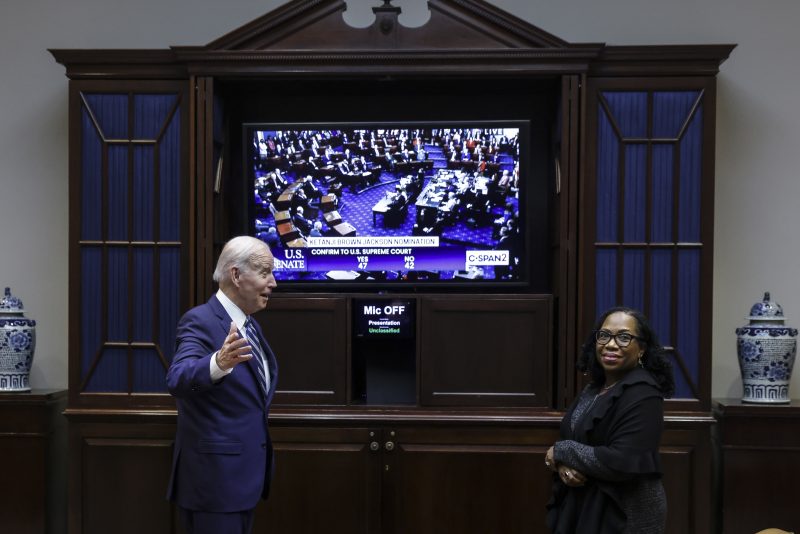
Biden has appointed many judges but hasn’t recast the bench like Trump
This week, the Senate confirmed President Biden’s 100th judicial nominee. And though Democrats hailed the milestone — Senate Majority Whip Richard J. Durbin (D-Ill.) noted that this outpaced both Trump and Obama’s judicial confirmations — Biden hasn’t been able to remake the judiciary like his predecessor.
Today there is increasing emphasis on which party appointed which judges, especially when they author significant, headline-making decisions. Recently, that’s included controversial decisions from a Trump nominee in the Mar-a-Lago documents case and the Supreme Court’s overturning of Roe v. Wade, which Trump had (correctly) assured his nominees would do.
As our politics have become increasingly partisan, judges have become an increasingly important metric of an administration’s success. Trump and then-Senate Majority Leader Mitch McConnell (R-Ky.) made a show of touting their work to revamp the federal judiciary (even as judges are supposed to be apolitical), and the Biden administration too has played up its own record-setting pace in confirming judges.
But while Biden’s overall pace has been somewhat faster than that of past presidents, his ability to reshape the judiciary in his own right has been much more limited — especially at the highest levels.
Thanks to several variables, Trump was able to completely recast not just the Supreme Court but the nation’s appeals courts — the most powerful judges below the nation’s highest court — by replacing judges that had been nominated by Democrats. Biden’s ability to reverse that has been stunted, and his appointees consist mostly of district court judges and replacing Democratic-nominated judges with new Democratic-nominated judges.
When Trump was elected in 2016, there were 18 more Democratic-appointed appeals court judges than Republican-appointed ones — 90 to 72.
But just two years later, that flipped. By the end of 2018, there were 16 more Republican-nominated judges — 97 to 81, a net gain of 34. Trump was able to flip three of 13 appeals court circuits from having a majority of Democratic nominees to a majority of Republican ones.
By contrast, as of November 2022, Biden had merely reduced the deficit he inherited, from a 17-judge gap to an eight-judge gap — a net gain of nine. And only one circuit flipped back from a majority of Republican nominees to a majority of Democratic ones. There continue to be more Republican-nominated appeals court judges, 91 to 83.
Here’s how that looks:
While the GOP under Trump increased its share of judges from 44.4 percent to 54.5 percent in Trump’s first two years, as of November Biden had increased Democrats’ share from 45.2 percent to just 47.7 percent.
The picture is similar at the district court level, where Democrats began Biden’s presidency closer to parity. In total, 48.8 percent of federal judges were nominated by Democratic presidents as of January 2021, according to the Pew Research Center. As of August, that number had risen to 51.65 percent.
The reasons Biden hasn’t made as much headway are complicated but mostly boil down to the fact that the GOP’s blockade of President Barack Obama’s Supreme Court nominee extended to other judges as well.
According to the Brookings Institution’s Russell Wheeler, Trump came into office with 17 appeals court vacancies to fill after Republicans controlled the Senate for Obama’s final two years and declined to confirm judges. None of the appeals court nominees Obama submitted in 2015 and 2016 were confirmed, which was a stark contrast to how a Senate led by the opposition party handled matters previously.
(Trump tried to suggest that Obama merely neglected to fill the vacancies, but that’s simply not true.)
Biden did not benefit from a similar dynamic, having come into office after Republicans controlled the Senate for all of Trump’s four years and prioritized confirming judges at a record pace.
Biden having two more years with a Democratic-controlled Senate should help his party confirm additional judges and perhaps close the gap at the appellate level (along with allowing them to fill any Supreme Court vacancies that might arise). But the Trump comparison should also temper expectations about just how much effect this may have.
As you can see in the chart above, the final two years of Trump’s presidency featured relatively little movement in balance of Republican-nominated and Democratic-nominated appellate judges. That’s in large part because judges tend to time their retirements to allow the party that nominated them to pick their replacement.
But the alternative — Republicans being able to block any attempts to fill vacancies should they arise, including at the Supreme Court level — was surely less attractive to Democrats heading into 2022 midterms. And for two elections in a row now (and with some help from Trump), they have been able to avoid that worst-case scenario.
This story has been updated with the latest news.
